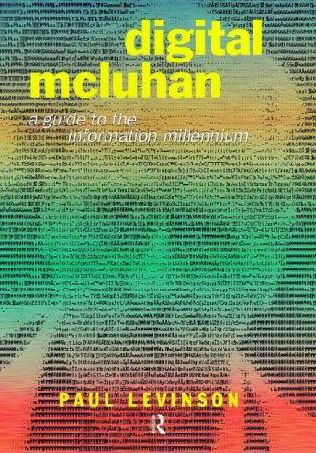Paul Levinson: Digital McLuhan: A Guide to the Information Millennium (1999)
Filed under book | Tags: · computing, global village, internet, mass media, media, media theory

“Marshall McLuhan died on the last day of 1980, on the doorstep of the personal computer revolution. Yet McLuhan’s ideas, developed in the 1950s, ’60s and ’70s, presaged a world of media in motion, and its impact on our lives on the dawn of the new millennium. McLuhan’s phrase, “the medium is the message” is his best known and most misunderstood concept. Paul Levinson presents the accuracy of McLuhan’s thinking unavailable while he was alive, and shows him as a man struggling to communicate in an electronic pattern via the straightjacket of paper. Levinson also examines why McLuhan’s theories about media are more important to us today than when they were first written, and why the Wired generation is now turning to McLuhan’s work to understand the global village in the digital age. By exploring the technological influence in industries from publishing to politics, entertainment to business, McLuhan opened the doors for understanding the human relationship with technology. Levinson’s own exploration of McLuhan’s significance in the new electronic generation clarifies the prophetic insights, principles and constructs in McLuhan’s work.”
Publisher Routledge, 1999
ISBN 041519251X, 9780415192514
226 pages
Keywords and phrases: personal computer, theremin, rear-view mirror, Marshall McLuhan, tetrad, Connected Education, Neil Postman, RealAudio, mass media, CP/M, Communications Decency Act, global village, Media Ecology, Internet, Gutenberg Galaxy, Paul Levinson, voyeurs, Eric McLuhan, Kaypro, RealVideo.
PDF (updated on 2022-11-12)
Comments (4)Vilém Flusser: Writings (2002)
Filed under book | Tags: · art, code, history, image, media, media theory, philosophy, photography, technical image, theory

Ten years after his death, Vilém Flusser’s reputation as one of Europe’s most original modern philosophers continues to grow. Increasingly influential in Europe and Latin America, the Prague-born intellectual’s thought has until now remained largely unknown in the English-speaking world. His innovative writings theorize—and ultimately embrace—the epochal shift that humanity is undergoing from what he termed “linear thinking” (based on writing) toward a new form of multidimensional, visual thinking embodied by digital culture. For Flusser, these new modes and technologies of communication make possible a society (the “telematic” society) in which dialogue between people becomes the supreme value.
The first English-language anthology of Flusser’s work, this volume displays the extraordinary range and subtlety of his intellect. A number of the essays collected here introduce and elaborate his theory of communication, influenced by thinkers as diverse as Martin Buber, Edmund Husserl, and Thomas Kuhn. While taking dystopian, posthuman visions of communication technologies into account, Flusser celebrates their liberatory and humanizing aspects. For Flusser, existence was akin to being thrown into an abyss of absurd experience or “bottomlessness”; becoming human required creating meaning out of this painful event by consciously connecting with others, in part through such technologies. Other essays present Flusser’s thoughts on the future of writing, the revolutionary nature of photography, the relationship between exile and creativity, and his unconventional concept of posthistory. Taken together, these essays confirm Flusser’s importance and prescience within contemporary philosophy.
Edited by Andreas Ströhl
Translated by Erik Eisel
Publisher University of Minnesota Press, 2002
Electronic Meditations series, Vol 6
ISBN 0816635641, 9780816635641
229 pages
review (Sean Cubitt, Leonardo Reviews)
PDF (updated on 2012-7-17)
Comment (0)Journal of Media Sociology 1(1/2) (Winter/Spring 2009)
Filed under journal | Tags: · media, politics, popular culture, sociology, television
This peer-reviewed scientific journal publishes theoretical and empirical papers and essays and book reviews that advance an understanding of the role and function (and dysfunctions) of mass media and mass communication in society or the world.
With contributions by Robin R. Means Coleman, Mark Deuze, John Hatcher, Amani Ismail, Mervat Youssef and Dan Berkowitz, Leo W. Jeffres, Kimberly Neuendorf, Cheryl Campanella Bracken and David J. Atkin, Ruben P. Konig, Hans C. Rebers, and Henk Westerik.
Edited by Michael R. Cheney
ISSN 1940-9397
130 pages
PDF (updated on 2014-8-28)
Comment (0)
